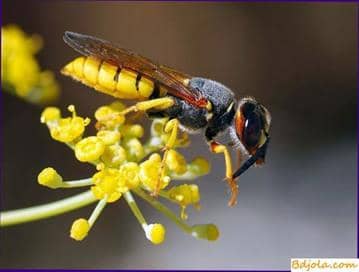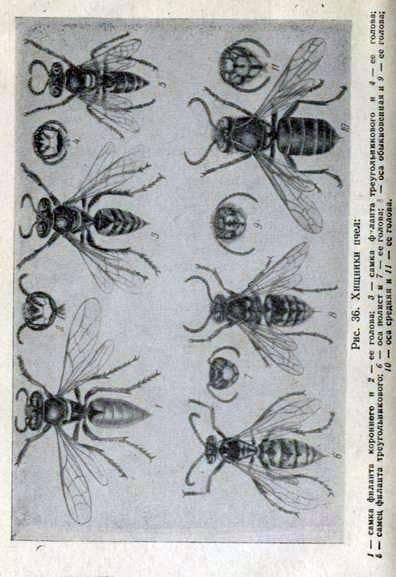
The philanthos triangu-lum F. is a strong and very mobile single earth wasp that, in the adult insect stage, is nourished by the flower nectar or the goiter of the bee-gatherers, and in the larval stage by the adult bees paralyzed by the sting of the female philanthropist.
The philanthropist is widely distributed in the middle and southern regions of the country. The habitat of the philanthropist are areas of developed beekeeping, where it multiplies rapidly and causes great harm to beekeeping.
Adult philanthropist of bright yellow color alternating with black. Black paint to the head and to the abdomen almost merges. Head is large, with strong jaws.
Between the tentacles on the front of the head there is a characteristic crown pattern for the philanthropists, which differs from the male and the female.

Male and female are different in size and appearance.
The male is about 12 mm long, it is smaller than the female. The head is large, with a pattern of a three-pronged crown; breasts are already somewhat head; the abdomen is long, on a thin stalk. The chest and lower abdomen are black.
The middle of each segment of the abdomen is colored with a black stripe, which tapers at regular intervals, bordering the strip of the yellow section. The male does not have a sting.
The female is about 15 mm long, has a much broader head with strong jaws. Crown pattern is two-toothed. The female breast is much wider and larger. The abdomen is mostly yellow and slightly black. In the middle of the back, spear-shaped black wedges directed with the point pointed back.
The anterior pair of legs of females has, for digging the nests on the last segments, setae arranged in the form of a comb. The abdomen of the female ends in a thin sting.
The windless sunny weather without precipitation, with a temperature of 20-25 њ and more, is most favorable for their reproduction. Under such conditions, males and females spend most of the day on fields and meadows among flowering plants and feed on their nectar. The temperature is below 15 њ, and the rainy and windy weather is unfavorable for the philanthropists. In these cases, the philanthropists stop flying on flowers and are hammered into nests until more favorable weather is established. Bees are an indispensable condition for the life of philanthropists. Without them, the philanthropists are dying out.
Predators of bees are only females of philanthropists. They catch working bees while they are harvesting nectar. The philanthropists attack bees not only on flowers, but also during the flight in the field and in the apiary. The female of the philantine, noticing the approaching bee, rushes swiftly at her. Being stronger, she grasps the bee with her jaws and pierces her short sting in the junction between the front and middle chest or front chest and head.
Under the influence of the philanthropic, the nerve nodes of the breast paralyze the stung bee. The bee completely loses mobility. From the paralyzed bee, the female philantine extracts the nectar, pushing the bees with her paws to her belly. After that she throws the bee. If she has a nest ready, she carries the bee there as food for feeding the larvae.
The female lives 25-40 days. During her life she tears out 4-8 earth nests. In each nest puts 3-6, and sometimes up to 8 paralyzed by his sting of adult bees. In each nest, the female lays one egg, which attaches to one of the bees. Egg white, 4-6 mm long, cylindrical, slightly curved.
An egg leaves in 3-4 days a larva, white, legless, well segmented, cigar-shaped. The anterior end is thinner and has a small head. The posterior end is thicker. The larva feeds on bees placed in the nest, and grows rapidly.
No other insects can replace bees as food. After 4-5 days it reaches the stage of an adult larva, having a length of 12-15 mm. The pupa begins after the cocoon is spinning. An adult larva for a few days spins a large shiny, dark brown bottle-shaped cocoon. It is impenetrable for water and slightly permeable for carbon disulphide and cyanic acid. In the pupa stage the philanthropist remains for about 10 months and tolerates severe winters without harm. From the cocoons come adult insects – males and females.
The philanthropists usually arrange their nests in dry, light, sandy-loamy, podzolic and rarely in loamy soils. They willingly settle on level ground or southern slopes of fresh road embankments, in places protected from winds and open to the sun, free of trees and thick grass. The nest digs a female, which has digging crests on the front legs. With the help of jaws and front legs, she quickly loosens the ground and throws it back. On the surface of the earth around the hole formed a round tubercle of loose ground a few centimeters tall and 12-16 cm in diameter, reminiscent of the shape of the overturned saucer. The hole diameter in the ground is about 0.9-1.0 cm.
Stroke in the soil digs in an oblique direction up to 30 – 80 cm or more in length. At the end of the turn makes an extension, where the nest is arranged. Sometimes the course has branches for the device of several nests. At night and in inclement weather, philanthropists burrow into the ground or climb into the nest. From the nests, the philanthropists usually go out during the hottest time of the day: from 11 to 17 hours. The season of mass appearance of philanthropists coincides with the hottest part of the summer and the mass reproduction of bees – the beginning of swarming up to the honey collection, inclusive, ie, until the second half of August.
The damage from the philanthropist is very large. The theft of bees occurs outside the apiary and in the apiary. Attacks of philanthropists on bees are so frequent that bees stop flying for a bribe.
To find nesting places for a philanthropist, the search is carried out in the middle of summer. On bare soils from vegetation, you can observe round heaps of land, the size of an overturned saucer. However, such heaps of land can form other insects. Therefore, it is necessary to open several nests. The presence in them of corpses of bees or remnants of them should indicate the ownership of burrows only to philanthropists, since no other earth insects catch bees. On the contrary, the absence of bees in them indicates the belonging of the nests to other hymenopterans.
In summer, in the middle of a hot, sunny day, honey plants are examined. They can find adult philanthropists, especially males.
Control measures.
The struggle with the philanthropists is to open up the soil occupied by their nests, and sow it with thick grass or planting a forest. The philanthropist can settle only on the soil that is bare of vegetation. The same results are achieved by flooding the soil with water, covering it with straw, foliage, brushwood, tree branches, etc. Applying poisonous substances to the nests: solutions of carbon disulphide, potassium cyanide, hexachlorane, etc.
For catching and destroying the philanthropists in the middle of the day, moves into the nests fall asleep and trample down. Returned from flight, females dig out their moves. At this time, they are destroyed.
They also struggle with the philanthropist by lubricating the earthen entrances into their nests with nigrol, solar oil and the addition of insecticides.
The most effective means of combating the philanthropist is the removal of the bees from the nesting sites of the philanthropists at the time they take out larvae, i. e. in July and August, at a distance of 50-100 km.
Что вредно для пчел. Торт без меда.
Predator bees